The Vatican Museums are a collection of many museums located within the walls of Vatican City. The first museum was initiated by Pope Julius II in 1503 and generally speaking the popes were the first European sovereigns who opened their palaces to the public introducing the public to their extensive art collections and with that a better understanding of art history and culture. In 2006 the Vatican Museums celebrated their 500th birthday and now there are approximately two dozen museums averaging more than 5,000,000 visitors every year.
Admission to the museums, which includes the Sistine Chapel, is €16 however make sure you purchase your tickets online before heading to the Vatican which allows you to completely skip the que and head directly into the museums. This will save you up to three hours in line if you are in Rome at the height of the tourist season.
Deb & I took hundreds of pics as we wandered through as many sections of the museums as we could fit in and it was clearly a case of sensory and information overload as we tried to absorb and remember as much as we possibly could.
Although the art contained in the Vatican Museums is typically ancient, the central Courtyard of the Pinecone contains a large sculpture that was very cool however seemingly out of place with surrounding artefacts.
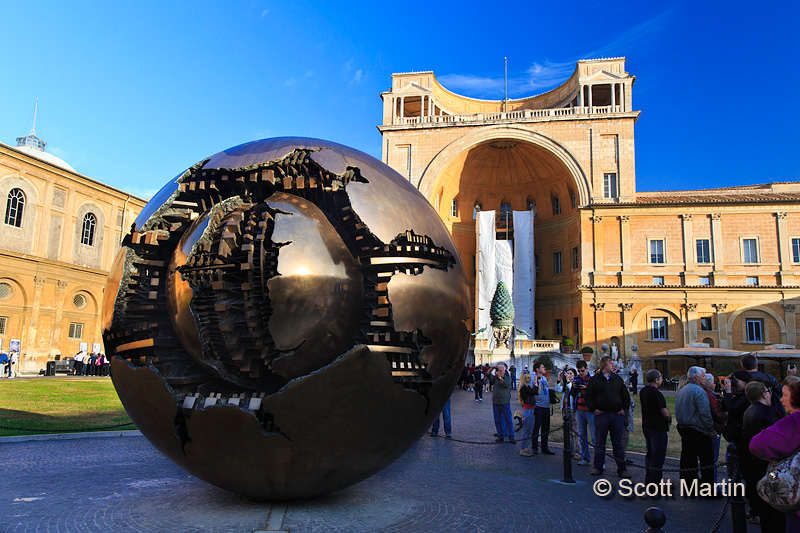
Named ‘Sfera con Sfera’ or Sphere within a Sphere, it is just over 13 feet in diameter and although it must weigh many tons it easily spins around its axis with a little elbow grease. The Pinecone (Pigna) in the back ground from which the courtyard gets its name is a first century Roman bronze that was originally the working centrepiece of a fountain located near the Pantheon. It is about 13′ high and was moved during the middle ages to the courtyard of the original St. Peter’s Basilica and then to its present location in 1608.
Although there are many ‘typical’ museum displays, the Vatican Museums catalogue and store thousands of artefacts which line the corridors of the many buildings that comprise the museums.
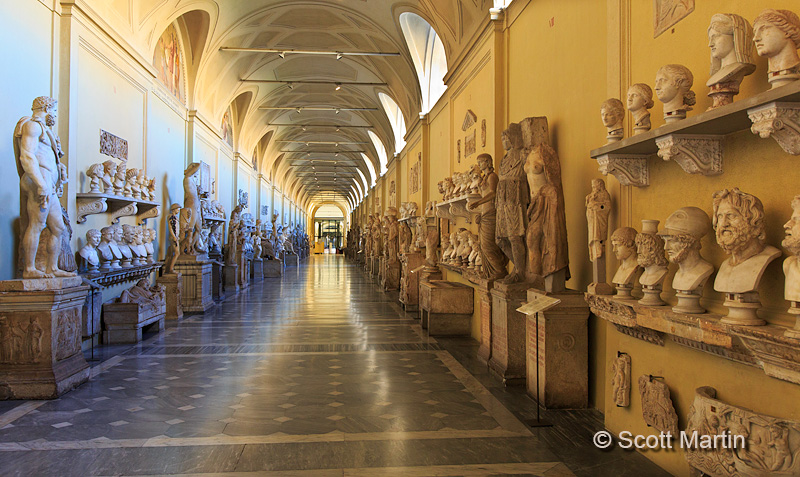
Located in the Round Room of the museum are two objects that were quite interesting, a gilded bronze statue of Hercules and one of the bathtubs from Nero’s palace.
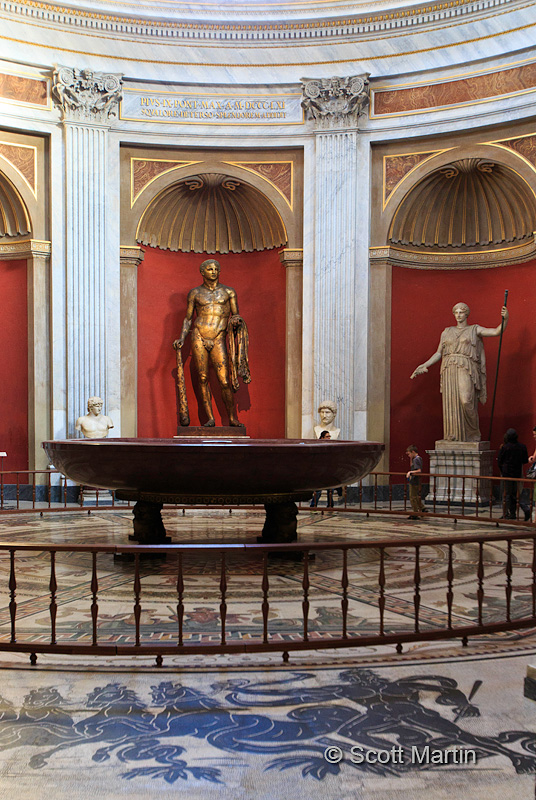
Nero was the Emperor of Rome from 54-68 AD. An evil tyrant who was a fierce opponent of Christianity, being responsible for the execution of thousands of Christians. His life was characterized by hedonistic excess that was epitomized by his royal palace, the Domus Aurea (Golden House) which he built after the great fire of Rome in 64 AD. In fact, it has been alleged that Nero started the fire in order to make room for his palace, hence the phrase “Nero fiddled while Rome burned”. Nero had his own mother executed as well as one of his wives and his step-brother was poisoned apparently at Nero’s direction. In 68 AD after being ousted from power, he committed suicide, the only emperor to do so.
At some level Nero’s life is represented by the bathtub pictured above. It was constructed of the rarest marble in the world, called Porphyry for its deep purple colour. Reserved for royals and only found on an Egyptian mountaintop some 800 km from Rome where it was mined by convicts and imprisoned Jews and Christians. Nero’s bathtub is almost twenty feet in diameter and stand almost six feet high on its ornate legs (note the people in the picture above for a reference point). The tub is valued at $100,000,000.00.
So while Nero rejected God and executed the Christians of the first century church, who did he worship? Probably the mythological Greek gods, like Hercules, who is seen above overlooking Nero’s bathtub. The gilded bronze larger than life-size statue of Hercules that stands in the Vatican is thought to date back to the first century. It was found in 1864 neatly buried under travertine stones in the area that was once Pompey’s Theatre. The stones protecting the statue were engraved with the letters FCS which means that the statue was struck by lightning and according to Roman tradition granted a ritual burial together with the remains of a lamb.
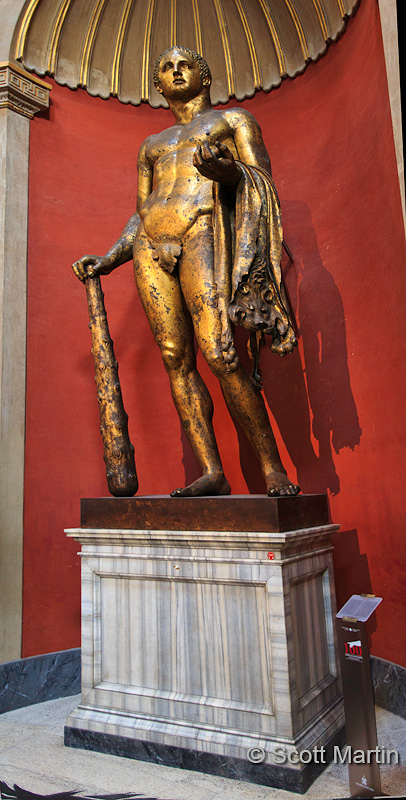
The detail contained in artworks of the past are impressive as shown in the white marble animal below that functions to support the marble base that rests on its back.
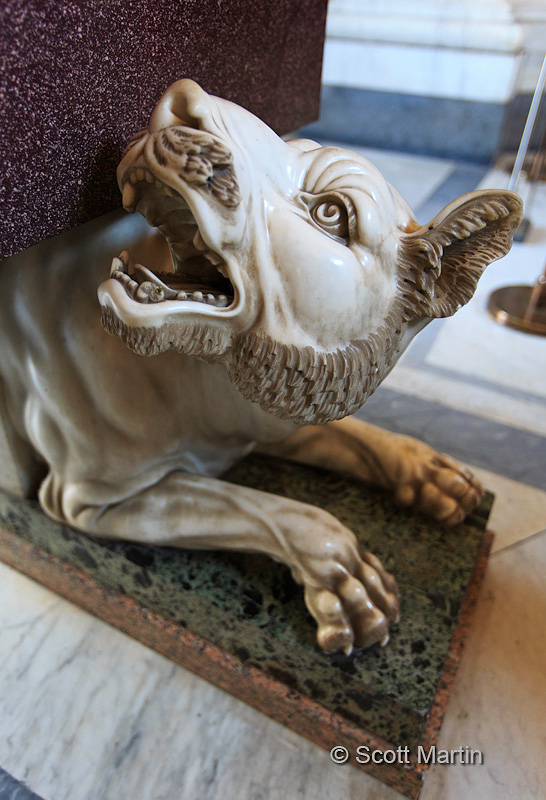
The Gallery of Tapestries contains a number of Flemish tapestries that were made in Brussels in approximately 1523 and first displayed at the Vatican in the Sistine Chapel in 1531. The tapestries were given their own gallery in 1838 and remain there today. The exquisite detail and colour in the stitching of the tapestries is incredible, especially when you consider they are almost 500 years old. You forget they are essentially carpets so in the image below I’ve purposely kept the edge visible on the right to remind you. The tapestry is titled Supper at Emmaus showing the risen Lord eating with the men He joined while walking to Emmaus (Luke 24:13-35).
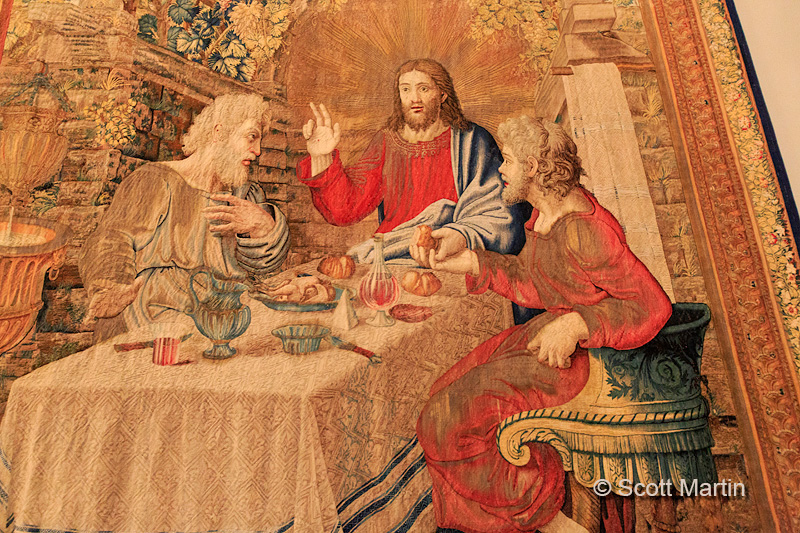
Probably one of the most popular galleries in the Vatican is the 120m hallway leading towards the Sistine Chapel known as the Gallery of Maps. Commissioned in 1580 by Pope Gregory XIII it contains 40 large topographical maps of Italy. The gallery took three years to build and has a ceiling that is as impressive as the maps that adorn its walls.
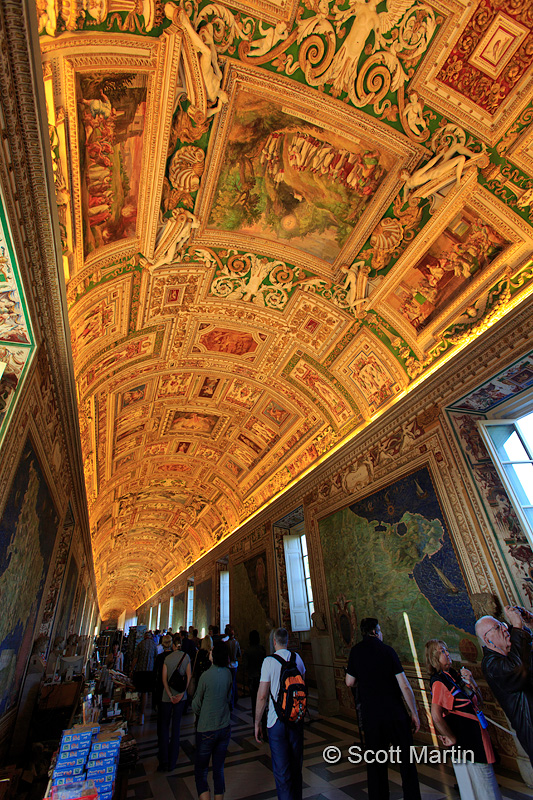
At the end of the Gallery of Maps you go down a small narrow flight of steps, pass through a rather nondescript doorway and find yourself in one of the most visually stunning rooms in the world, the Sistine Chapel; the Pope’s private chapel and home to Michelangelo’s most famous works that adorn the walls and ceiling. The Sistine Chapel is perhaps the world’s most well-known chapel and one of its oldest with construction through 1473-1481. It is part of the Papal Palace and is interesting in that it lacks a grand entrance typical of churches and there are no entrances or exits directly to the outside. The Sistine Chapel measures 134 x 44 feet, patterned after the size of Solomon’s Temple. The vaulted ceiling rises 68′ above the floor.
When entering the chapel for the first time, it was the vibrancy of the colours that surprised me the most. I was expecting subdued colours, especially on paintings that are 500 years old, however they are actually bright and vibrant.
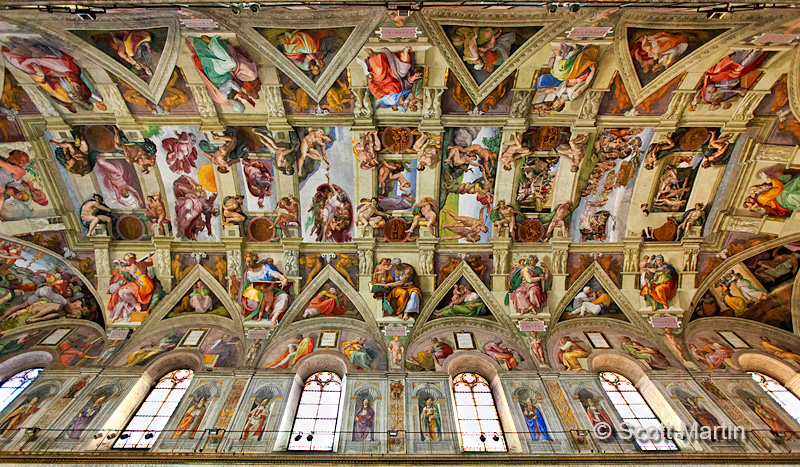
Michelangelo was commissioned by Pope Julius II in 1508 to paint the ceiling, which he completed between 1508 and 1512. In total the frescos painted on the ceiling covered over 5,000 square feet and contained more than three hundred figures.
Michelangelo painted “The Last Judgement” on the wall behind the altar from 1535-1541.
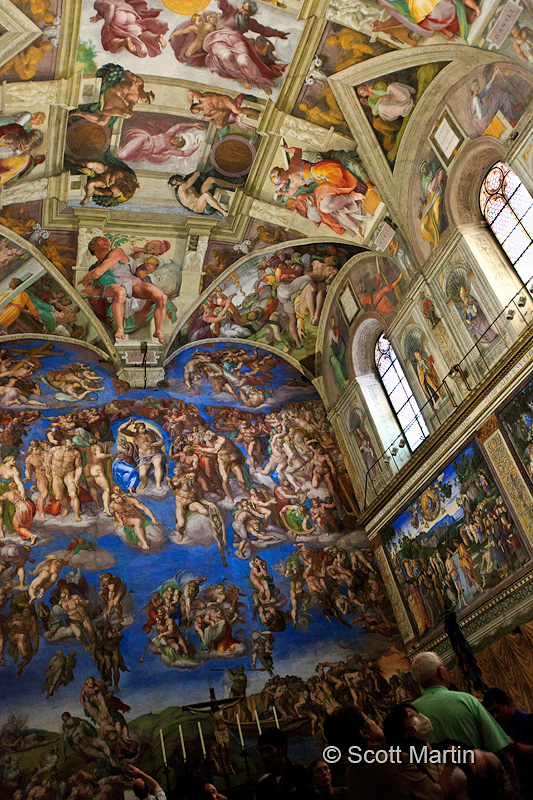
There is some debate whether Michelangelo painted the ceiling lying down or standing up. Either way it is generally agreed that scaffolding was built at a level above the top of the windows which would by design block the viewing of the ceiling from the floor beneath. This means that the figures on ceiling were painted without the benefit of having the proper proportional perspective that would be available from the floor. That Michelangelo could paint such large figures at such close range and maintain proper proportional relationships is truly remarkable as demonstrated in “The Creation of Adam”, perhaps the most famous of the ceiling panels.
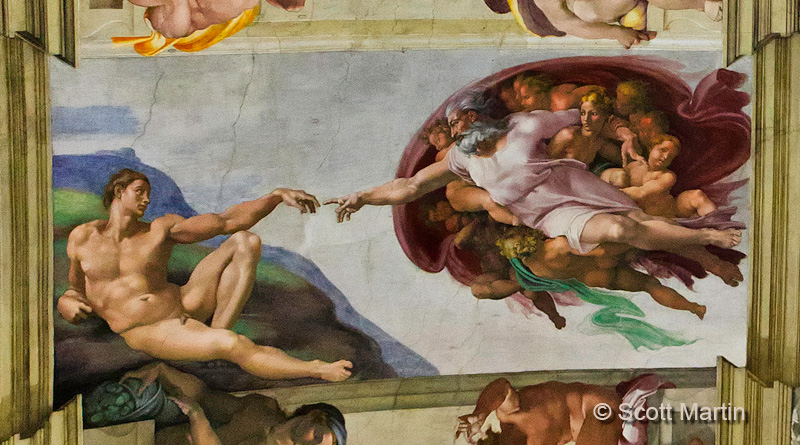
We left the Sistine Chapel and headed through a small maze of hallways that comprised a short cut to St. Peter’s Basilica, along the way passing a small store selling Vatican remembrances.
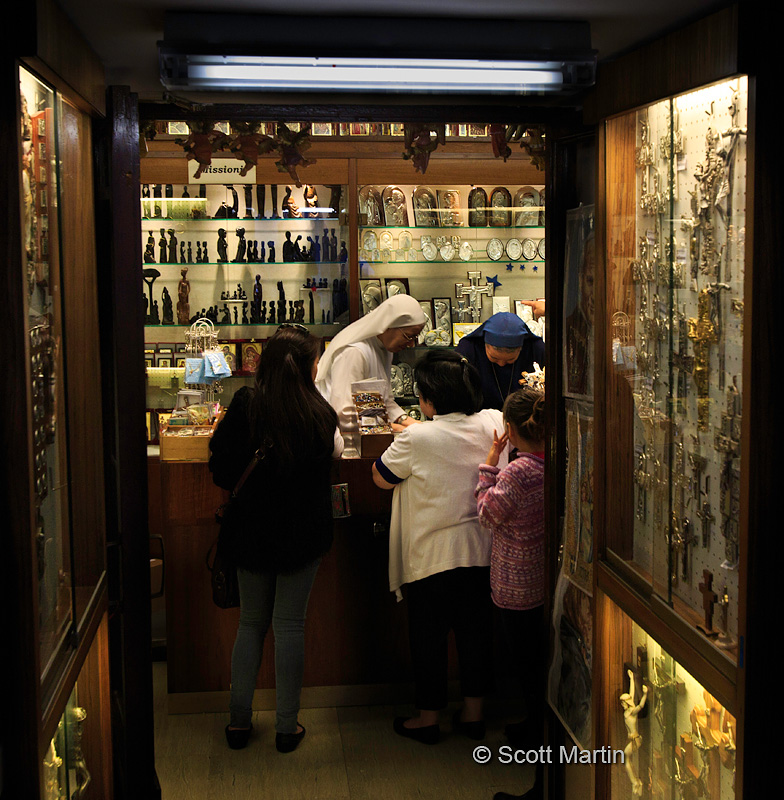
One of the many things I will remember from our day at the Vatican was the sheer size of everything, which is quite ironic given that the Vatican is the smallest country in the world. Even in an alleyway between the Sistine Chapel and St. Peter’s Basilica that sees little traffic, the person in the bottom of the next image provides a great example of the scale of the Vatican.
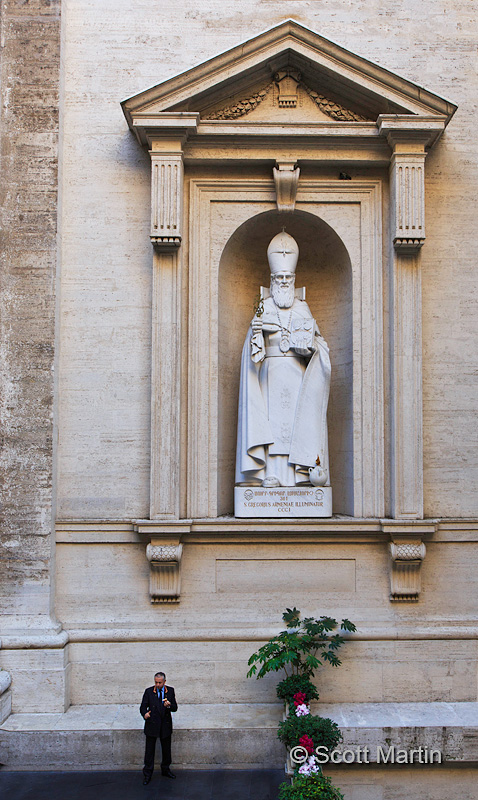
After concluding our time in Rome we headed to the train station to pick up our rental car and begin the next leg of our trip; the 540km drive to Venice, which will be the subject of the next blog posts.


Yet another terrific post Scott. Dianne and I plan to visit this part of the world at some point, meanwhile I will live vicariously through your great images. The photos inside the Sistine Chapel must have been particularly difficult with all of the other visitors jostling for position and I assume you were hand holding your camera.
Thanks Arni and I’m glad we can live vicariously through each others photography! Yes, all the pics were handheld with lots of leaning on walls and holding one’s breath.
Wow Scott, simply stunning lesson in history backed by fantastic shots. Dianne & I really enjoyed going through this. Looking forward to Venice
Thanks Rob and I’m happy you & Dianne enjoyed them.